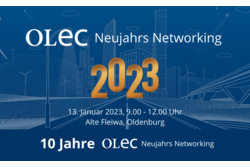
The Dutch provinces of Drenthe and Groningen and the state of Lower Saxony are strengthening cross-border cooperation to develop hydrogen projects. Lower Saxony's Minister for Federal and European Affairs and Regional Development, Birgit Honé, spoke about this with her Dutch counterparts Melissa van Hoorn (Groningen) and Tjisse Stelpstra (Drenthe) on Wednesday, March 16, during a working visit to Lingen.
"The northern Netherlands and Lower Saxony are very similar in several ways: their proximity to the sea, the potential for large-scale hydrogen production, storage in salt caverns, large industrial clusters, innovative companies, e.g. in the field of logistics" says Drenthe's regional minister, Tjisse Stelpstra.
His Groningen colleague, Regional Minister Melissa van Hoorn, adds: "It is therefore obvious that we work together. This is already happening in sub-projects, but we can intensify this cooperation even more." They therefore agree with Lower Saxony's Minister Birgit Honé: "Together we can become Europe's first cross-border Hydrogen Valley."
The state and the Dutch provinces want to push ahead with connecting the "Hydrogen Valleys" on both sides of the border on the basis of existing projects and activities. This involves networking hydrogen projects and taking advantage of a new EU funding program.
In the northern Netherlands, the cooperation concerns the HEAVENN project, which includes the development of the "GZI Next" energy center in the city of Emmen and projects in and around the Eemshaven and Delfzijl areas. In northwestern Germany, this involves the H2 region of Emsland and "HyWays for Future" in the Northwest metropolitan region. These projects focus on the entire hydrogen value chain: from the production of green hydrogen to transport, storage and use in industry, mobility and buildings.
By supporting collaboration between private sector organizations and research institutions and jointly developing projects, the regions can link the supply and demand for hydrogen across regions. This strengthens knowledge exchange and employment, and leverages economies of scale leading to lower prices for green hydrogen. This makes the use of hydrogen more attractive, accelerating the energy transition and making us more independent of foreign energy imports more quickly.
As part of the cooperation, the state of Lower Saxony and the two North Dutch provinces want to provide targeted support to companies and knowledge institutions from the border region that apply for the new funding program of the "EU Clean Hydrogen Partnership". A budget of 121 million euros is available under this program. In addition, it is being examined whether funding applications can be submitted jointly with other regions, for example in the Baltic states, in order to be able to set up a hydrogen tank infrastructure with 150 hydrogen trucks along part of the North Sea-Baltic Sea corridor between Rotterdam and Hamburg.
The provinces of Drenthe and Groningen, as well as the state of Lower Saxony, have been exploring even closer cooperation in the field of hydrogen for some time. The New Energy Coalition, the H2 region Emsland and the German energy company EWE are also involved in this. In the coming months, the regions will further concretize and expand their cooperation.
Text and image: H2 Region Emsland
Translated with www.DeepL.com/Translator (free version)












